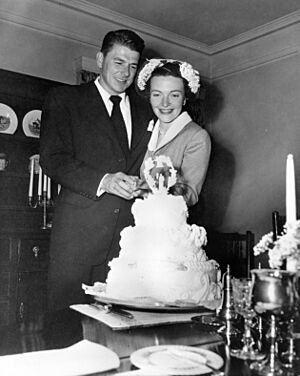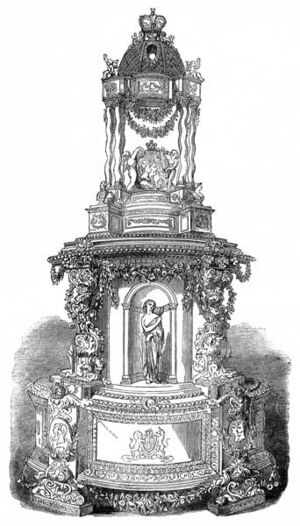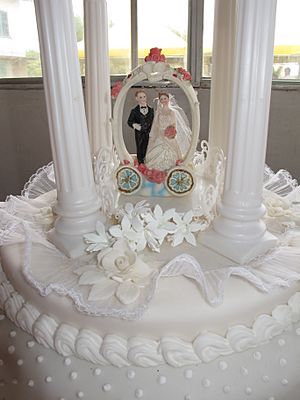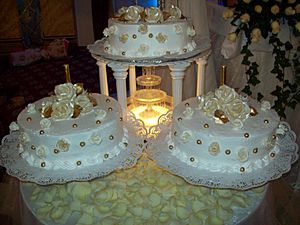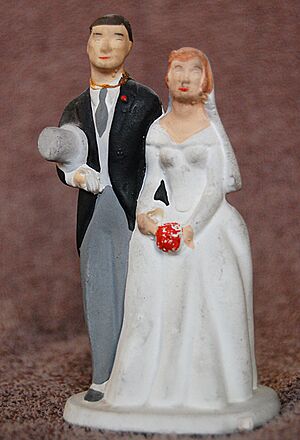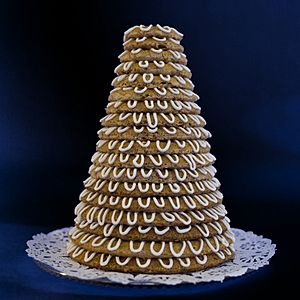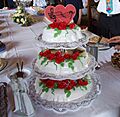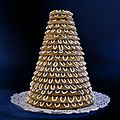Wedding cake facts for kids
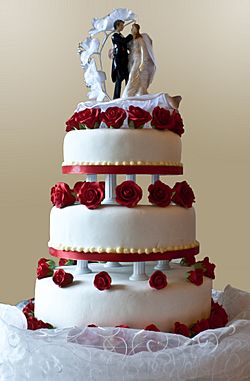
A three-layer wedding cake with pillar supports and "topper" figures
|
|
| Type | Cake |
|---|---|
A wedding cake is a special cake served at wedding receptions. These parties happen after the wedding ceremony. In some parts of England, the cake is served at a "wedding breakfast." This doesn't mean it's in the morning. It just means it's the first meal after the ceremony on the same day.
Today, in many Western countries, the wedding cake is often shown off. It is usually served to guests at the party. Long ago, wedding cakes were made to bring good luck to everyone. Now, they are often a beautiful centerpiece for the wedding. Sometimes, only the bride and groom share a small edible part.
Contents
What is a Wedding Cake?
Wedding cakes come in many sizes. The size depends on how many guests will be at the wedding. Modern pastry chefs, who are like expert bakers, use many tools and ingredients. They create cakes that often show the couple's personalities.
Popular ingredients include Marzipan, fondant, gum paste, buttercream, and chocolate. The price of a cake changes with its size and ingredients. Cakes are usually priced per person or per slice. This can range from a few dollars to hundreds of dollars per slice. It depends on the chef who makes the cake.
Wedding cakes and cake decorating have become very popular. TV shows like Cake Boss and Amazing Wedding Cakes show how these amazing cakes are made.
The History of Wedding Cakes
The first wedding cakes might have been made in ancient Greece. The idea of a wedding cake has grown from many different traditions.
One early tradition started in Ancient Rome. People would break a cake made of wheat or barley over the bride's head. This was meant to bring good luck to the couple.
Early European Wedding Cakes
From the 1500s to the 1600s, a "bride's pie" was common at weddings. This was not a sweet cake like today's. It was a savory pie. It could be filled with things like oysters or lamb parts. Some recipes even had live birds or a snake inside! Guests were expected to eat a piece to be polite. Not eating it was thought to bring bad luck.
One fun tradition with the bride's pie was to hide a glass ring inside. The young woman who found it was believed to be the next to marry. This is similar to today's tradition of catching the Flower bouquet.
In the 1600s, people started making two cakes. One was for the bride and one for the groom. The groom's cake later became less popular. The bride's cake became the main one. If both were served, the groom's cake was usually a darker, rich fruit cake. It was also much smaller. The bride's cake was often a simple pound cake with white icing. White was a sign of virginity and purity.
Wedding cakes were once a luxury. They showed how wealthy and important a family was. A bigger cake meant higher social status. In England and early America, wedding cakes were usually fruit cakes. They often had many layers and were covered with marzipan and icing. Cutting the cake was a very important part of the party. White icing also showed wealth in Victorian times. So, a white cake was highly desired. Today, you can find many flavors and styles.
In Medieval England, cakes were stacked as high as possible. The bride and groom would try to kiss over them. A successful kiss meant they would have a happy life together. This idea led to the Croquembouche. A story says a French Pastry chef saw this tradition. He then went back to France and stacked sweet rolls into a tower. This created the first Croquembouche. This cake is still popular in France today. It is made from Profiteroles and covered in spun sugar.
In 1703, a baker's helper named Thomas Rich wanted to marry his boss's daughter. He wanted to make a very fancy cake. He got his idea from St Bride's Church in London.
Traditionally, the bride would put a ring inside her part of the cake. This showed she accepted the marriage proposal. The bride's pie slowly changed into the bride's cake. This new dessert was sweeter and no longer a pie. It was usually a plum or fruit cake. In the mid-1700s, cakes started having two layers of icing. The top white icing was used to create colorful, three-dimensional decorations. Some decorations were not meant to be eaten. The idea that eating the cake brought good luck continued. However, the glass ring tradition faded. The Flower bouquet toss took its place.
Modern Western Wedding Cakes
The bride's cake became the modern wedding cake we see today. In the early 1800s, sugar became easier to get. But very pure white sugar was still expensive. Only rich families could afford pure white frosting. This showed their wealth and social status. When Queen Victoria used white icing on her cake, it became known as royal icing.
The modern wedding cake style started at the 1882 wedding of Prince Leopold, Duke of Albany. His wedding cake was the first to be fully edible. Pillars between cake layers appeared about 20 years later. These pillars were often simple broomsticks covered in icing. The layers showed wealth, as only rich families could afford them.
Prince Leopold's cake was made in separate layers with very thick icing. When the icing hardened, the layers could be stacked. This was a big step for wedding cakes. Modern wedding cakes still use this method. They also add dowels inside the cake for support. This helps hold up larger cakes.
What Wedding Cakes Symbolize
Wedding cakes have been part of weddings for hundreds of years. They weren't always the main focus. They also came in different forms, like pies or bread. There has always been a lot of meaning linked to the wedding cake. The first known sweet wedding cake was a Banbury cake, popular in 1655.
The color white has been linked to weddings since the Victorian era. This started when Queen Victoria wore a white lace wedding dress in 1840. White was already a symbol of purity in Western cultures. The wedding cake was called the bride's cake. So, white became common to match the bride. It also showed the family could afford expensive white sugar.
Cutting the cake is also full of meaning. In China, the couple starts cutting a multi-layer cake from the bottom. They give the first pieces to their parents and older relatives. This shows respect for their family's foundation.
Wedding Cake Superstitions
Many superstitions surround the wedding cake. In traditional American weddings, young women were invited to pull ribbons from the bottom layer. Only one ribbon had a charm or ring. The person who got it was believed to be the next to marry.

In other countries, the wedding cake is broken over the bride's head. This is to ensure she will have children and bring good luck. Some people today believe eating wedding cake crumbs brings good luck. This is because the cake stands for happiness and a good life for the new couple.
There are also myths about bridesmaids dreaming of their future husbands. Hopeful bridesmaids would take a piece of cake home. They would place it under their pillow. Some would even sleep with cake pieces in their left stocking. They would pass the cake through the bride's wedding ring first.
In the medieval era, wedding cakes were stacks of rolls and buns. The groom and bride would try to kiss over the stack. This was to ensure they would have children and good fortune.
Types of Wedding Cakes
Different types of cakes are popular in different countries. In some places, like Italy, couples choose different cakes based on what they like. In others, one type is most common. Even then, the popular type can change over time. For example, the traditional wedding cake in Korea was a rice cake. Now, sponge cake with fresh fruit is more common.
Cake Styles
The typical modern white wedding cake is a decorated white layer cake. It is usually covered and decorated with frosting. The layers might be filled with frosting, pastry cream, lemon curd, or other fillings. It can be topped with decorations made from frosting, edible flowers, or other items. A layer cake can be one cake or many stacked layers.
Very tall layered cakes are important in Indonesia. The total height of the cake is said to predict how successful the couple will be. In the US, three layers have been the most common choice since the 1960s.
In Appalachia, a stack cake was a way for poorer people to celebrate. Guests would each bake thin cakes. These cakes were then stacked on top of each other. The layers were usually filled with apple butter or cooked apples. This shared the cost among the community.
Among the Cajuns in the US, the bride's family bakes many cakes at home. They do not have one large cake.
Cake Flavors
In the United Kingdom and Australia, the traditional wedding cake is a rich fruitcake. It is decorated with icing and may have almond paste. Fruitcake was also the traditional wedding cake in the US until the mid-1900s.
A survey showed that in the 1960s, 70s, and 80s, most US wedding cakes were white or yellow. In the 2000s and 2010s, there were more flavors. But most were still white or chocolate cake.
In Greece, the traditional flavors were honey, sesame seed, and quince. Now, an almond torte is more common. Greek wedding cakes are fancy and often have many layers.
In the Philippines, the cake might be vanilla sponge cake. It could also be a purple ube cake. White cake is currently the most popular flavor in the US. But different fillings can be added. Chocolate, carrot, Italian Rum, and Italian Cream are also popular.
Groom's Cake
In some areas, especially the American South, two cakes are served. A large, white layered cake is called the bride's cake. A second cake, with a different flavor, is called the "groom's cake." This tradition came from England. Early American settlers thought the white bride's cake was too light for men. The groom's cake was usually a dark, liquor-soaked fruitcake.
More recently, groom's cakes are often chocolate. Or they are another of the groom's favorite flavors. The groom's cake can be shaped like something important to him. This could be a hobby item, a sports team symbol, or something from his job. The movie Steel Magnolias showed a red velvet groom's cake shaped like a giant armadillo.
Bermuda has a different tradition of two cakes. The bride's cake is a three-layer fruitcake. The groom's cake is a pound cake. The bride's cake is decorated with silver and means good fortune. The groom's cake is decorated with gold. It represents his role as the head of the family. The groom's cake is topped with a live cedar tree. This tree means the couple's love is growing. The couple later plants and cares for the tree.
Cake Decorations
Layered cakes often have flowers or columns between them. This adds height and looks nice. Separators can include jewels, shells, or flowers. Or they can be completely separated by metal stands.
Frosting can be smooth or have drizzles, swirls, or chips. Fondant is a type of frosting that is rolled out. It is then draped over the cake layers. It is a smooth, firm sugar icing. It can be cut into designs, shaped, flavored, or colored.
Flowerpaste or gumpaste is a soft dough. It is usually made from egg whites, gelatine, and powdered sugar. This dough is used to create flowers and other decorations for a cake. Because it has gum, it can be rolled very thin.
Royal icing is made with water, sugar, and egg white. It becomes hard when dry. It can be piped onto the cake or thinned for "flood work." This is when larger areas need icing. It dries fast and is great for making detailed shapes ahead of time. It can also be piped right onto the cake layers. It works well for delicate details.
A wedding cake may also be topped with fresh flowers. This is common in the Philippines.
Wedding cake toppers are small models or art pieces. They sit on top of the cake. In the US, the most common type shows a bride and groom in wedding clothes. This was very popular in US weddings in the 1950s. It showed togetherness. Toppers can also be figures that show shared hobbies or interests. Some are funny. In Mexico, the wedding topper and other decorations tell a story about the couple's past.
Other Wedding Desserts
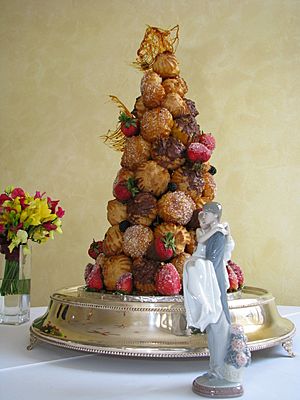
Instead of, or along with, a wedding cake, some people serve other desserts. These might include pastries or cookies.
Some weddings have stands with many layers of cupcakes. A small wedding cake might be placed at the top for the cutting ceremony. Cupcakes are cheaper than a large layered cake. They are also flexible. They can have many flavors, colors, and designs.
Croquembouche is a complex pastry. It is made of cream puffs and caramelized sugar. This pastry is the traditional wedding cake in France.
In Norway and other Scandinavian countries, a pastry called Kransekake is preferred. This is often made by the family. It is built from 18 rings, each slightly smaller, stacked to form a tower.
Kanom sam kloe is a fried pastry served at Thai weddings. Three balls of dough are fried together. They are made from coconuts and sesame seeds. There are beliefs about whether the dough pieces stay together. If they do, it is said to mean a successful marriage and at least one child.
After the Wedding
In Europe in the 1800s, cakes for a baby's christening were like wedding cakes. Wedding cakes were often fruitcakes, which stored well. Since the first baby often arrived within a year of the wedding, people started saving the top part of the wedding cake. They would eat it to celebrate their first child. More recently, some people freeze part of the cake. They save it until the couple's first wedding anniversary.
Images for kids
-
Ronald Reagan and Nancy Reagan cutting their wedding cake, 1952
-
Wedding cake from Cairo
-
Croquembouche wedding cake
See also
 In Spanish: Pastel de bodas para niños
In Spanish: Pastel de bodas para niños


